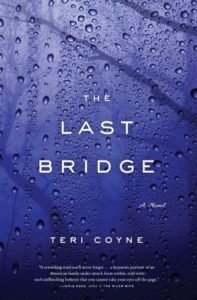
(Note: I’m still wrestling with a migraine, so I haven’t been able to update the blog very well. So I’m posting an older review of mine, which also appears on Goodreads.)
The Last Bridge, by Teri Coyne
psychological suspense
Summary:
Alex fled her abusive home years ago. Now she nurses her pain with bourbon and denial. She returns home after her father’s hospitalization and her mother’s suicide. Her mother has left a note for Alex: “He’s not who you think he is.”
Whom is she referring to? There are plenty of men to choose from. Is it her father, who has sexually and physically abused her? Her brother? Her former lover, Addison, who has suddenly reappeared with their son? Alex doesn’t want to deal with any of this. She avoids her brother and sister and numbs herself once more with alcohol.
Coyne interweaves the past and present, showing what has happened that lead up to her flight and what is happening as the children bury their mother, clean up the farmhouse and deal with their mutual feeling that they are more strangers than siblings. The two storylines finally connect and point toward an uplifting and hopeful resolution.
The book is dark and not for the faint of heart. At times, it’s hard to like Alex, who seems her own enemy, though not worse than her father or the alcohol she numbs herself with. But as the novel progresses, I understood her and developed sympathy for her. I wanted her to throw out the bottle, get help and find out the truth about the question that has tormented her for years.
But there were several bewildering elements of the novel.
1. First, the family tree itself is bewildering.
Saying anything else is a spoiler. But there are multiple points of confusion.
2. There are 2 trivial things that an editor should’ve picked up on:
Having three characters whose names start with the same letter is confusing:
- Alex, the narrator,
- Alex, her son
- Addison, the possible father of her child.
At the very least, why not have other characters call Alex the narrator by her nickname, Cat? (Almost no one calls her by her supposed nickname) And two Jareds? Please, this is too confusing!
The dual timeline was a great idea, but the execution is problematic.
On the plus side, we get to see what happens after the mother’s suicide and what lead up to the fateful night that forced Alex to leave home. But at points I had difficulty figuring out whether the events were happening in the past or present. It would have made sense to add chapter headers telling when the events in the chapters happened; Jodi Picoult did this in The Pact and Nineteen Minutes, and it added clarity to the timelines. A simple “then” and “now” indicator would have helped. I’m not sure why an editor didn’t suggest this, unless the reader is meant to be slightly confused because Alex herself confuses the past and present, with all the abuse and fear and addiction rolling together.
3. The ending is abrupt.
I wish there had been more development at this point. (I’ll add, though, that I really liked seeing a nun portrayed in a positive light. It’s not often that religion on fiction is used to help and not harm.)
Having said all that, you might think that I disliked the book. Au contraire.
I read—no, devoured—it in one afternoon, mesmerized by Coyne’s story. I didn’t want to put it down. That doesn’t happen very often for me. I wanted to know what happened to Alex and I wanted to know what her mother’s suicide note meant. He isn’t who you think he is.
But it wasn’t just the fast-paced plot that made me keep reading. While I read, I thought of all the truth contained in this story, how realistic the family dynamics are in these circumstances, how I know of other families that have lived this story.
It’s a heartbreaking look at how abuse destroys a family.
No one here can trust another family member. No one besides her brother even bothers to protect Alex, and even he can’t protect her from the worst.
Everyone else turns a blind eye:
- her mother and sister, one caught up in her abusive, co-dependent relationship and the other self-centered and spoiled, pretend not to see the obvious;
- teachers ignore the bruises and cuts of the children;
- Addison apparently doesn’t realize that Alex is being abused or is too immature to act responsibly and get her help.
It’s the syndrome that I’ve seen in news stories about battered women, abused children or victims murdered by a loved one. “I heard a rumor that he beat her, but it wasn’t my business. . . . I guess I should have realized when she had that black eye. . . . I didn’t know what to do. . . . So I did nothing.”
If there’s one thing to take away from the book, it’s that we all know an Alex. Maybe we’re even Alex ourselves.
For the latter, Coyne offers hope. For the rest of us, Coyne kicks us hard, letting us know in no uncertain terms to wake up and see the Alex’s all around us. And don’t just see. Do something.
(Need resources to help? I strongly urge you to contact RAINN, which has a national sexual assault hotline. Check out my top 5 books on predators for additional ideas.)
